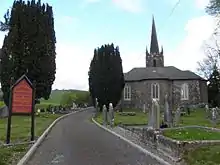Tomregan
Tomregan (Irish: Tuaim Dreagain, IPA:[ˈt̪ˠuəmʲˈdʲɾʲaɡənʲ]) is a civil parish in the ancient barony of Tullyhaw. The parish straddles the international border between the Republic of Ireland and Northern Ireland. The largest population centre in the parish is Ballyconnell, County Cavan. The total area of the civil parish is 10,600 statute acres. Most of Tomregan's constituent townlands are situated in County Cavan while the remainder lie in County Fermanagh. In the Catholic Church, the ecclesiastical parish of Tomregan was split in the early 18th century, with the County Fermanagh townlands being assigned to the parish of Knockninny while the County Cavan townlands were united with the parish of Kildallan.

The townlands
The Fermanagh townlands in Tomregan civil parish are- Aghindisert, Carickaleese, Cloncoohy, Derrintony, Derryart, Garvary, Gortahurk, Gortaree, Gortineddan, Gortmullan, Knockadoois, Knockateggal, Tonymore and Ummera.
The Cavan townlands in Tomregan civil parish are- Agharaskilly, Aghavoher, Annagh, Aughrim, Berrymount, Carrigan, Carrowmore, Cavanagh, Clifton, Cloncollow, Corranierna, Cranaghan, Cullyleenan, Derryginny, Doon, Tomregan, Fartrin, Gortawee or Scotchtown, Gortoorlan, Moher, Mucklagh, Mullaghduff, Mullanacre Lower, Mullanacre Upper, Mullynagolman, Rakeelan, Slievebrickan, Snugborough, Sralahan[1] (also called "The Common").
Etymology
The name Tomregan is a corruption of the original Gaelic name Túaim Drecain, which means literally "tumulus/hill/mound/tomb of a dragon", similar to Loch Bel Dracon now Lough Muskry in the Galtees, County Tipperary (The lake of the dragon's mouth). P.W.Joyce in 'Irish Local Names Explained' suggests that in this particular case it means a man's name or nickname "Drecon's burial mound". Drecain is also the plural of dracon and is used to figuratively mean 'warriors', similar to the French language where 'dragon' also means a cavalry soldier which passed into English as 'dragoons'. So Tomregan means either 'The burial mound of Drecon' or "The burial mound of the warriors". Edmund Hogan's 'Onomasticon Goedelicum' give the following variants of the name which occur in old Irish manuscripts- "Tuaim Dracon (al. T. Drecon): Ll. 360; ¶ in Ui Briúin Breifne, Sb. 4 a, Lec. 63; ¶ al. Tuaim Dreccon; ¶ Tuaim Drecon in Uí Briúin Breifne, Lg. 91, Mi., Mr., Fg., Tp.; ¶ T. Drecain, Ls., F., Fg., Tp., Mm.; ¶ in breifne Ui Raghallaig, Md.; ¶ Tuaim Dreagain, K. 131 b; ¶ now Tomregan p., which is in cc. Cavan and Ferm., in which there is a schoolhouse at Tomregan, Pgi. iii. 376". The 'D' is aspirated and the medial "c" in 'drecain' is pronounced /g/ which gives its present pronunciation 'Tom Regan'. Alternatively the Dindshenchas states that the name Tuaim Drecain is derived from the grave of Regan Anglonnach, one of the Formorians- Tell me the famous cause whence Tuaim Regain is named. Brefne, daughter of Beoan mac Bethaig, a brave soldier-woman, fell in conflict for that land with the Children of Ham, with their evil power. Regan of the Children of impious Ham, from the army of strong-smiting Balar, was a warrior of prowess and exploits, whom none could face in equal battle. Regan it was, dangerous beyond dispute, that engaged the combat; he was leader of the retinue of red-armed Oengus mac ind Oc, with all his army. The warrior went his way in good sooth, when he had slain the soldier-woman, to demand an unjust tribute from the hosts of the Gael, though an unrighteous claim. There met him, face to face, unaided, the king's son of the Gael; they fought a stern fight, hard by the rock of Asual's son. The spot where the Fomoir's head was struck off—it was a doughty deed—is called after him Tuaim Regain: I hide not from thee the cause of the name.[2][3]
Historical events
The main events in the history of Tomregan as listed in the ancient sources are-
- The killing of Regan, the Fomorian, at Tomregan in 1860 BC.[4][5]
- The Battle of Tuaim Drecain in 1342 BC by the High King Eochaid Faebar Glas.[6]
- The murder of the Ulster hero Conall Cernach in the 1st century BC at Áth na Mianna (Ballyconnell).[7]
- The birth of St. Dallan Forgaill, the Chief Ollam of Ireland, in c.530 AD
- The foundation of the University of Tuaim Drecain by the Synod of Drumceat in 584 AD.[8]
- The brain surgery in 636 on Cenn Fáelad mac Ailella
- The Vision of Saint Bricín c. 640.[9]
- The Irish Rebellion of 1641 deposition concerning Knogher mc ffarrell oge o Rely of Tomragin.[10]
References
- "Townlands in Tomregan".
- Lebor gabála Érenn, Poem XCVIII
- The Death of Conall Cernach at Ballyconnell, Co. Cavan, by Tom Smith in Breifne Journal 2012
- History of Ireland, page 97
- Edition available from CELT
- MS 833, fols 217r-218v
